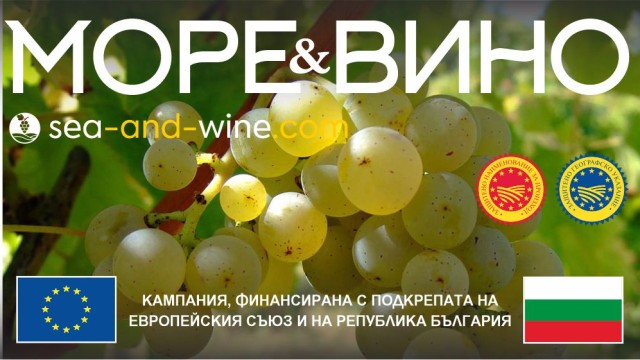PDO AND PGI WINES FROM SAUVIGNON BLANC VARIETY FROM THE BLACK SEA REGION
Sauvignon Blanc is a white wine grape variety and is one of the most widespread and sought after in the world.
It is moderately resistant to low winter temperatures. It gives the best results on lighter and more permeable humus-carbonate, cinnamon-forest and gray forest soils in airy areas and on hilly terrains. The vines are characterized by strong growth, high fertility and high yield.
On the vine, sauvignon blanc takes a lot of work, especially when its roots find enough water. Then begins an extremely abundant growth of the vine and the winemakers are forced to constantly remove the excess leaves, which would otherwise shade the grapes and not allow their full ripening. The variety ripens relatively late, which protects it from spring frosts. It ripens in late August, early September. It is not resistant to powdery mildew and gray rot, but it is resistant to mildew.
The crown of a young shoot is greenish-white, densely smoky, with pink-edged leaves covered with a white cobweb. The one-year mature shoot is reddish brown. The bunch is small and medium (10-13 cm long, 6-10 cm wide), cylindrical, sometimes with a lobe, very dense. The stem of a grape is short. The average weight is 75-120 g. The berry is small and medium (15-17 mm long, 14-16 mm wide), round and slightly oval, often deformed, greenish-white, acquires a yellowish-pink complexion in the sun. The pulp is juicy, harmonious taste, with a specific aroma. The average weight of 100 fruits is 130 g. There are 2-3 seeds per berry. From the beginning of the opening of the buds to the ripening of grape fruits, 130-135 days pass at a sum of active temperatures of 2700 ° C. The shoots are medium in size. Ripening of shoots is good. Sauvignon has a low to medium yield. Fruiting shoots 37-80%, the number of clusters per developed shoot 0.6, per fruiting 1-1.2. Shoots that have developed from replacement and dormant buds are sterile.
The moderate-continental climate, strongly influenced by the proximity of the Black Sea, with the characteristic breeze circulation, the relatively dry summer and the long and warm autumn, influence the development of specific characteristics of the variety in this region, making it suitable for PDO and PGI registration.
The composition of the grape,%: juice - 77.8, bunch - 4, skin, dense parts of cellulose and seeds - 18.2. The variety belongs to the group of high-quality technical varieties. The sugar content in the fruit at harvest reaches 18.6-23.1 g / 100 ml, acidity 6.4-11.1 g / l. It is often used as an improving variety in blends with Aligote, Riesling and others, giving finesse, fullness of taste, stability of aroma.
The bunch is small to medium-sized, cylindrical-conical, slightly winged, compact. The grains are small, spherical to slightly elliptical. The skin is yellow-green, only when fully ripe they are yellow-amber, with an abundant wax coating. The meat is juicy, sweet, with a pleasant taste. Sauvignon Blanc is a valuable white wine variety. From its grapes, high-quality varietal and blended white dry, semi-dry and sweet wines are prepared, which are distinguished by a transparent yellowish-green color, fresh and harmonious taste and aromas of hay, tropical fruits and gooseberries.
Its juicy and crisp acids, as well as attractive aromas, quickly manage to make it a universal favorite. The interesting thing about it is that it is able to reflect specific viticultural and oenological approaches in a remarkable way. And depending on that, it comes in two styles: 'green' and 'yellow'. Whichever style it is aged in, it is generally produced in steel vessels without any contact with oak. However, this does not prevent it from having the potential to age for several years. Through them to develop interesting nutty aromas.
The "green" style is characterized by intense, recognizable aromas of green pepper, asparagus, grass, nettle, ivy, gooseberry and kiwi, ideally accompanied by hints of limestone and wet rock; fresh, tight, juicy and very aromatic body.
In the "yellow" style, the nose is dominated by ripe pear, quince, melon, elderberry, acacia, white and yellow flowers and toasted bread crust.
This variety is suitable for green leafy salads, asparagus dishes, fish and seafood dishes, oysters, goat cheese. Due to its specific acids and aromas, the variety does not fit into the generally accepted rules for white wine and food: for example, it does not go well with chicken and poached eggs. Precisely because of this specificity, it is particularly suitable for an aperitif.
The "Sea and Wine" project aims to raise awareness about the benefits of PDO and PGI registration, thereby increasing the competitiveness of wines from the Black Sea region.
More information can be found on the official website: www.sea-and-wine.com

